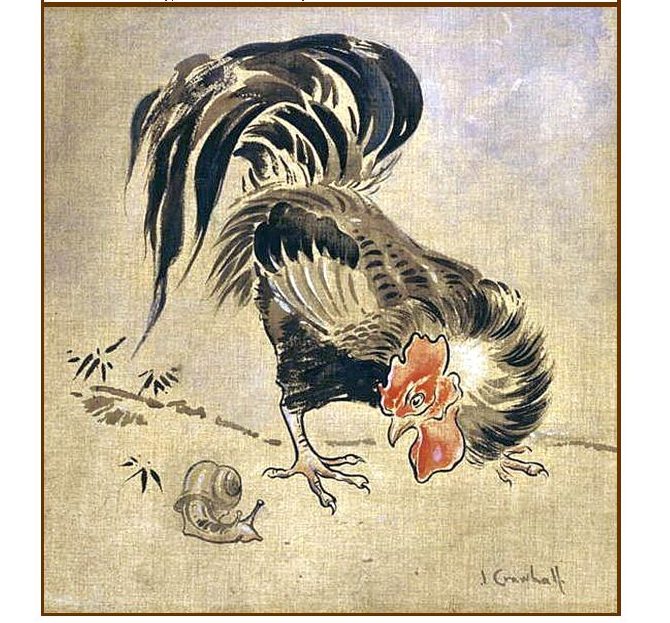Maidir le coiligh — the Irish for ‘The Year of the Rooster’ and a few other phrases Posted by róislín on Jan 29, 2017 in Irish Language
(le Róislín)
Ábhair don am seo den bhliain (in ord croineolaíoch): coileach, peil Mheiriceánach, crosóg, úitseach, agus cárta Vailintín. Remember all these? They were the subject of the most recent blogpost (nasc thíos), looking at five events or holidays that occur in late January or early-to-mid February.For the next couple of blogposts, we’ll look a little closer at some of those images, starting with “an coileach” (the rooster), the siombail for this year’s lunar new year (siombail bhliain nua na gealaí don bhliain seo, 2017).
So today we’ll look at different forms of the word for “rooster” in Irish and also at the painting used to illustrate today’s post, which is by the British artist, Joseph Crawhall III (born Morpeth, Northumberland, 1861; died London, 1913). And since that painting also includes a certain type of mollusk, we’ll also look at the Irish for “snail.”
Basic forms first:
an coileach, the rooster
an choiligh, of the rooster (Bliain an Choiligh, The Year of the Rooster)
Note what happens when we want to say “The Year of the Rooster” — “coileach” becomes “choiligh” [KHIL-yee], a typical genitive case ending for this 1st-declension noun.
na coiligh, the roosters
na gcoileach, of the roosters (círíní na gcoileach, the combs of the roosters)
As for the style of Crawhall’s painting in the graphic above, we see the influence of Impressionism (Impriseanachas) and Japonisme, for which I find no official Irish term, but which I assume would be “*Seapáineachas,” along the lines of “pointileachas” (pointillisme) and “Fóbhachas” (Fauvisme). The artist is associated with the “Glasgow School” of the 1890s to the 1910s. Other affiliated artists are Charles Rennie Mackintosh, his wife Margaret MacDonald, his sister Frances MacDonald, and Herbert MacNair. In addition to Impriseanachas and *Seapáineachas , the Glasgow School incorporated styles of the Athbheochan Cheilteach (Celtic Revival) and traidisiún na nEalaíon agus na Ceardaíochta (the Arts and Crafts tradition), and would no doubt be worthy of a blog or more in its own right, as would, of course, the Celtic Revival in Ireland. Lá éigin!
Now that we’ve dealt with the bunfhoirmeacha and the ealaíontóir, let’s check out one more interesting aspect of the painting. Cén Ghaeilge atá ar “snail”? Leid: seacht litir (__ __ __ __ __ __ __ ) agus é ina fhocal nach ndéanfar dearmad go deo air a fhad is a bhíonn daoine ag éisteacht leis na Clancy Brothers. Cén fáth na deartháireacha sin? Cloiseann muid an focal Gaeilge traslitrithe mar “Shellicky” san amhrán páiste a cheoladh siad, “Shellicky Bookey.” An aithníonn tú anois é?
“Seilide” atá ar “snail” i nGaeilge. Tá difear réasúnta mór i litriú agus i bhfuaimniú na bhfocal “shellickey” agus “seilide” ach is iad leaganacha an fhocail chéanna iad. Ar chuala tú an t-amhrán? Tá leagan Béarla de freisin, “Snail, snail, come put out your horn, Tomorrow is the day to shear the corn.” Cén fáth adharc amháin in ionad dhá adharc (mar tá dhá adharc ag seilide)? Sin rud nach bhfuil a fhios agam ach amháin an pointe seo, don leagan Béarla, ní dhéanann “horns” agus “corn” rím. Ní deir muid “corns” i mBéarla ach amháin má bhíonn muid ag caint faoi “corns” ar an gcos (fadharcáin).
Bhuel, sin é, coileach, Impriseanachas, seilide agus dornán focal suimiúil eile. Tá súil agam gur bhain tú sult as. Slán go fóill — Róislín
Nasc don bhlagmhír dheireanach: Cúig phictiúr d’imeachtaí an tséasúir: Irish words for some festivals and events from late January through mid FebruaryPosted by róislín on Jan 27, 2017 in Irish Language

Build vocabulary, practice pronunciation, and more with Transparent Language Online. Available anytime, anywhere, on any device.





Leave a comment: